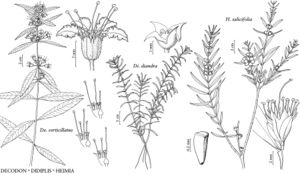Difference between revisions of "Heimia salicifolia"
Enum. Hort. Berol. Alt. 2: 3. 1822.
imported>Volume Importer |
imported>Volume Importer |
||
| Line 55: | Line 55: | ||
|publication year=1822 | |publication year=1822 | ||
|special status= | |special status= | ||
| − | |source xml=https://xjsachs2@bitbucket.org/aafc-mbb/fna-data-curation.git/src/ | + | |source xml=https://xjsachs2@bitbucket.org/aafc-mbb/fna-data-curation.git/src/e39f0e846f172941159b2045254d62d10d9823f6/coarse_grained_fna_xml/V10/V10_534.xml |
|genus=Heimia | |genus=Heimia | ||
|species=Heimia salicifolia | |species=Heimia salicifolia | ||
Latest revision as of 10:32, 9 May 2022
Stems narrowly 4-winged or 4-angled. Leaves 15–55[–87] × 2–10 mm. Floral tube 5–9 × 3–4 mm; epicalyx segments linear-corniform, 2–2.5 mm, apex often in-curved; sepals 1.5–2 × 1.5 mm; petals broadly obovate, 5–10(–14) × 3–5 mm. Capsules globose, 3–4.5 × 3.5–5.5 mm. Seeds 0.5–0.8 × 0.2–0.3 mm. 2n = 16 (Mexico, Bolivia).
Phenology: Flowering spring–summer.
Habitat: Moist soil, streamsides in brushland.
Elevation: 0–1500 m.
Distribution
Tex., Mexico, South America, introduced in West Indies, Central America.
Discussion
Heimia salicifolia has an extensive native distribution from northern Argentina to southeastern Texas, with a gap in Central America. The species is employed in Mexico and parts of South America in traditional medicine and religious rites to induce mild auditory and visionary hallucinogenic effects. The array of medicinal applications also includes use as a strong anti-inflammatory, soporific, diuretic, and antisyphilitic, and for healing wounds. The effects obtained are due to the synergy of alkaloids present in the leaves (M. H. Malone and A. Rother 1994).
Selected References
None.
